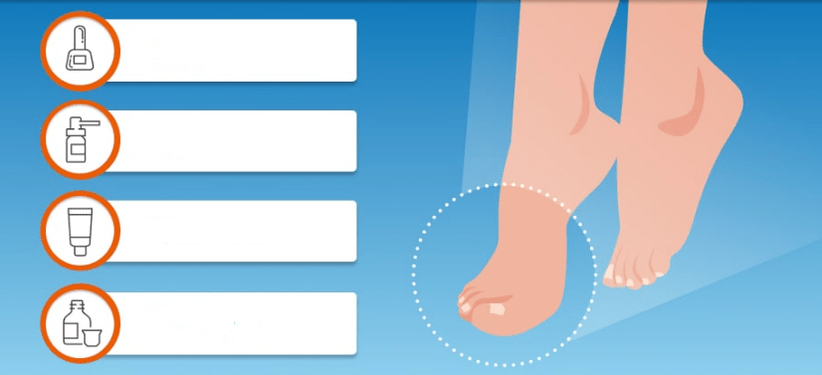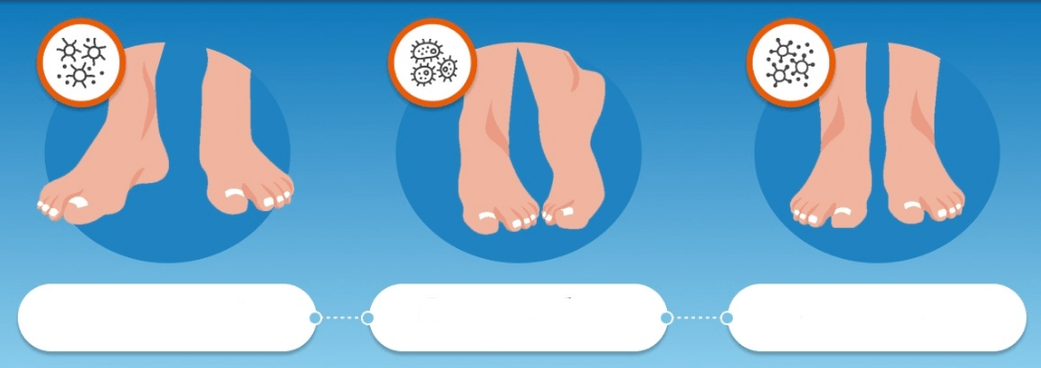Nail fungus (onychomycosis) is diagnosed on average in 10-15% of the world’s population, and among people over the age of 60, its incidence reaches 30-50%. Men suffer 1. 3 times more often than women, which may be due to an irresponsible attitude towards the problem. It is difficult to get rid of onychomycosis, but it is possible, and the main task of doctors and patients is to choose the right remedy for nail fungus. We talked about what a drug is and how it works.
Is therapy necessary for the fungus?
Many people, especially older men, ignore fungal treatments, believing that the problem is only aesthetic and, other than cosmetic defects, does not cause any consequences. This is a rather dangerous misconception. We explain why.
First, the fungus is highly contagious. If you do not pay attention to treatment, the infection will spread quickly. The causative agent of onychomycosis is easily spread through household items, and patients are at risk of infecting the whole family.
Second (and most importantly), nail fungus problems are not just cosmetic. Neglected diseases significantly reduce the quality of life: pain appears, difficulties arise with the selection of shoes and all sorts of household difficulties. Nail plates, which are affected by fungus, can collapse over time. But it's still half the problem. Without timely and proper treatment, onychomycosis harms the whole body. The risk of allergies is increased (due to the developing hypersensitivity to the fungus and its metabolic products), infectious complications often accompany (e. g. , erysipelas). Against the background of onychomycosis, any skin disease is worse. Not to mention chronic infections weaken the immune system.
So the answer is unequivocal: it is necessary to treat nail fungus, and as soon as possible. The farther the process goes, the harder it is to get rid of the disease. Therefore, therapy should be started at the first sign of injury. Another issue is how to treat. The variety of drugs is so great that it is easy to get confused. But you need to know how it works to understand which medications help get rid of nail fungus. We will tell about this.
Choosing a remedy for nail fungus
On the internet you can find many suggestions for combating fungus. Traditional medicine advises to get rid of it with the help of soda, ammonia, propolis, kerosene, celandine juice, essential oils. There are recipes for nail fungus remedy with vinegar, iodine, hydrogen peroxide. Using seemingly harmless home methods, patients only exacerbate the problem. There is no traditional medicine that destroys the onychomycosis pathogen, and lesions develop, covering the growing area on the nail plate. Eventually, the patient ends up in a dermatologist’s office with an advanced fungus that is very difficult to treat.
So advice number one - no self -treatment! If signs of the disease are found, it is necessary to contact a dermatologist who will prescribe an effective remedy for nail fungus. Self-medication is unacceptable, if only because onychomycosis is caused by various types of pathogens, and in each case it is important to choose the right active ingredient. And not to doubt the recommendations of experts, it is worth knowing how it works and how the drugs used to treat this disease differ from each other.
Means for the treatment of nail fungus can be classified according to the form of release and active ingredient. Of the other selection criteria, price category and ease of use are important.
Release form
External preparations against nail fungus are produced in the form of varnishes, sprays, creams (ointments) and solutions.

Antifungalvarnish, as a rule, women prefer, because with the help of such products it is possible to combine treatment with cosmetic care. Before processing, it is necessary to grind the surface of the nail plate with a file. After applying medical varnish, you can apply the decoration. This is the main advantage of this dosage form.
However, varnishes are not universal. First, it is effective only with a small area of damage. If the fungus has spread to more than a third of the nail plate, the remedy will not help. Second, the drug in the form of varnish can only overcome superficial mycosis. This is because it cannot penetrate the bottom layer of the nail. With deep wounds, when the nail plate thickens, antifungal agents in the form of nail polish will not work - stronger medications are needed.
Creams and sprays- similar shape: both have an oil base. They are ideal for the treatment of skin mycoses, which, by the way, often accompany nail fungus. This tool easily penetrates the lower layer of the epidermis, destroying pathogens. But nails have a denser structure, and oil -based preparations do not reach all sites of infection. Creams or sprays are best used as an additional part of the treatment of onychomycosis - with a corresponding fungal infection on the skin of the feet.
The solution- the optimal form of antifungal agent for nails. Drugs on a water-alcohol basis penetrate deep into the nail plate, filling voids and channels through which pathogens spread. Therefore, the fungicidal and fungistatic effects of liquid drugs for nail fungus are stronger than in other forms.
Active ingredients
Preparations against fungi are mainly materials of synthetic origin (rarely natural), various in chemical structure. Depending on it, the spectrum of their activity differs, that is, the action against certain pathogens. Given the fact that onychomycosis can be caused by various types of pathogenic fungi, the choice of the right active ingredient is very important.

Notes
To determine the type of pathogen with certainty, it is necessary to conduct a microbiological study of tissue fragments. But usually you can determine the type of fungus with the external features of the affected nail. The most common causative agent of onychomycosis is Trichophyton Rubrum. Less commonly, the disease is caused by other types of dermatophytes, such as yeast and mold fungi.
In terms of chemical structure, there are several groups of antifungal drugs:
Polyena. These include substances such as nystatin, levorin, amphotericin. When taken orally, they are active against many types of fungi, but topical application of these agents is effective only for candidiasis. Therefore, polyene is not usually prescribed for the treatment of onychomycosis.
Azoles. For external use, drugs based on the substances clotrimazole, econazole, miconazole, oxiconazole, isoconazole, bifonazole are used. Their action is mostly fungistatic - in other words, these drugs stop the growth of the fungus. The fungicidal effect (destruction of pathogens) is possible when a high concentration of the substance in the tissue is reached. Azoles are active against fungi and dermatomycetes such as Candida yeast, which cause skin lesions. With onychomycosis, these drugs are not very effective.
Allylamines. This is the main group of antifungal agents prescribed for the treatment of skin and nail mycoses. For topical use, terbinafine and naftifine -based products are suitable. The first is also prescribed orally in the advanced stages of the disease. Naftifine is an effective treatment for onychomycosis. It exhibits fungicide activity against dermatophytes (including Trichophyton Rubrum), yeasts and molds - in a word, possibly the main causative agent of fungal infections on nails. In addition, naftifine acts on many bacteria.
Of the other substances not included in this group, amorolfine and ciclopirox are used to treat onychomycosis. Both drugs are used topically, primarily as part of an antifungal varnish.
Ease of use
Getting rid of fungus is a long process. For several months, nail treatment will be a daily procedure, otherwise positive results will not be achieved. Given the duration of treatment, it is important to choose a tool that is easy to use. In the case of varnish, keep in mind that the surface of the nail must be ground before each use. Therefore, it is good if there are disposable files in the kit. In the case of a solution, it is better to choose a product packaged in a sealed bottle with a dropper stopper. The elongated dropper nose is easier for spot application of the solution where it can penetrate deep into the nail plate. This form is optimal in dosage: it is easy to measure and use the required amount of medication, which makes use more economical.
Packaging and course costs
Fungal treatment should be continued until full growth of healthy nail plates. With hand onychomycosis, this process takes about four months. Toenails grow more slowly on toenails and can take up to a year to heal. So buying an antifungal agent is not a one -time expense, but a regular expense item, and, of course, I want to reduce it as much as possible. However, the desire to save should not be exceeded: the main selection criterion is efficiency. A reasonable result is to focus on the active ingredient. Sometimes this makes it possible to choose widely advertised drug analogs that are similar in effectiveness, but more profitable in terms of price.
Onychomycosis not only reduces quality of life, but also threatens with serious complications. Therefore, when the first signs of infection are detected, it is necessary to consult a doctor as soon as possible and begin treatment.remedy for toenail and fingernail fungus with clinically proven effectiveness.
Solution for nail fungus
To combat nail fungus, you can use the drug in the form of a solution. The active ingredient of the drug is naftifine, a substance from the allylamine group, which is active against most types of pathogenic fungi. It destroys dermatophytes (Trichophyton, Epidermophyton, Microsporum), Candida yeast fungi, Aspergilla mold and other types of nail and skin fungal pathogens. The drug in the form of a solution penetrates into the thickness of the nail plate, moves along the path of spread of the fungus and creates a stable concentration of the drug in the zone of accumulation of infection.
The action of the drug is a fungicide, that is, it not only stops the growth of the fungus, but destroys it.
In addition, naftifine has antibacterial activity. Fungal diseases of the nails and skin are often complicated by bacterial infections, and the use of medications can solve both problems at the same time.
The additional effect of naftifine is anti-inflammatory. It helps reduce the redness, swelling, and itching that often accompanies fungal infections.
Indications for use of the solution include fungal infections not only on the nail plate, but also smooth skin, skin folds and interdigital lesions, as well as candidiasis, pityriasis versicolor, inflammatory dermatomycosis. The same range of indications for other products of the line - creams and sprays.
























